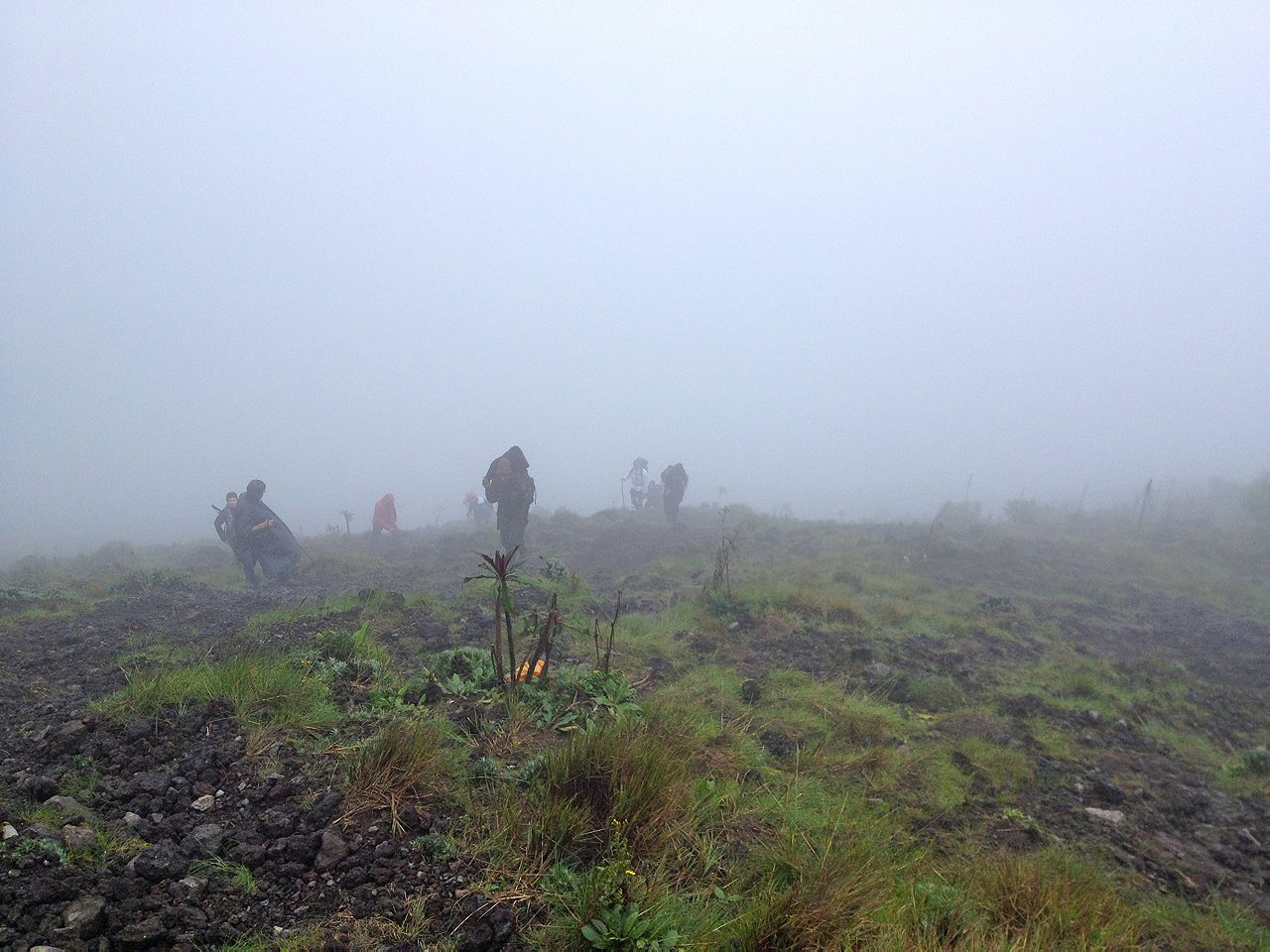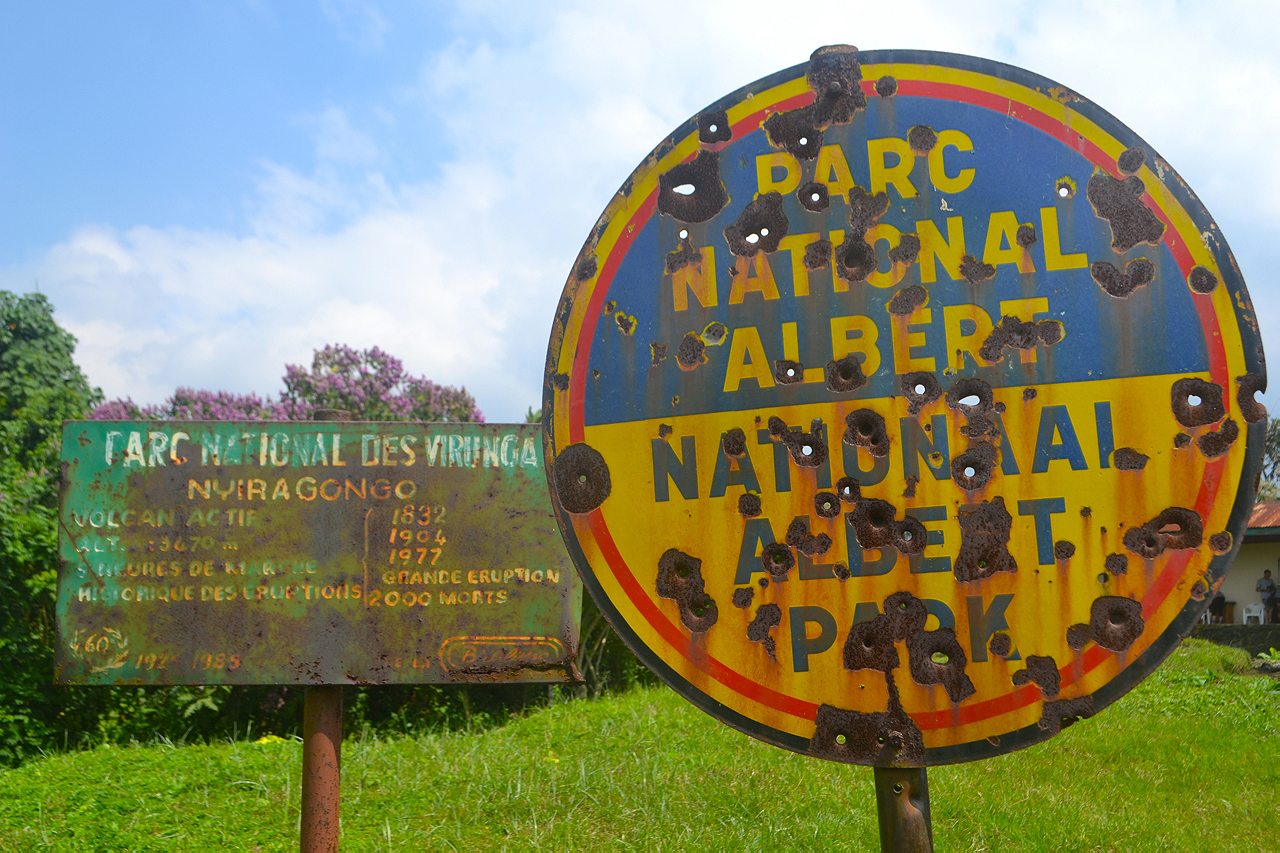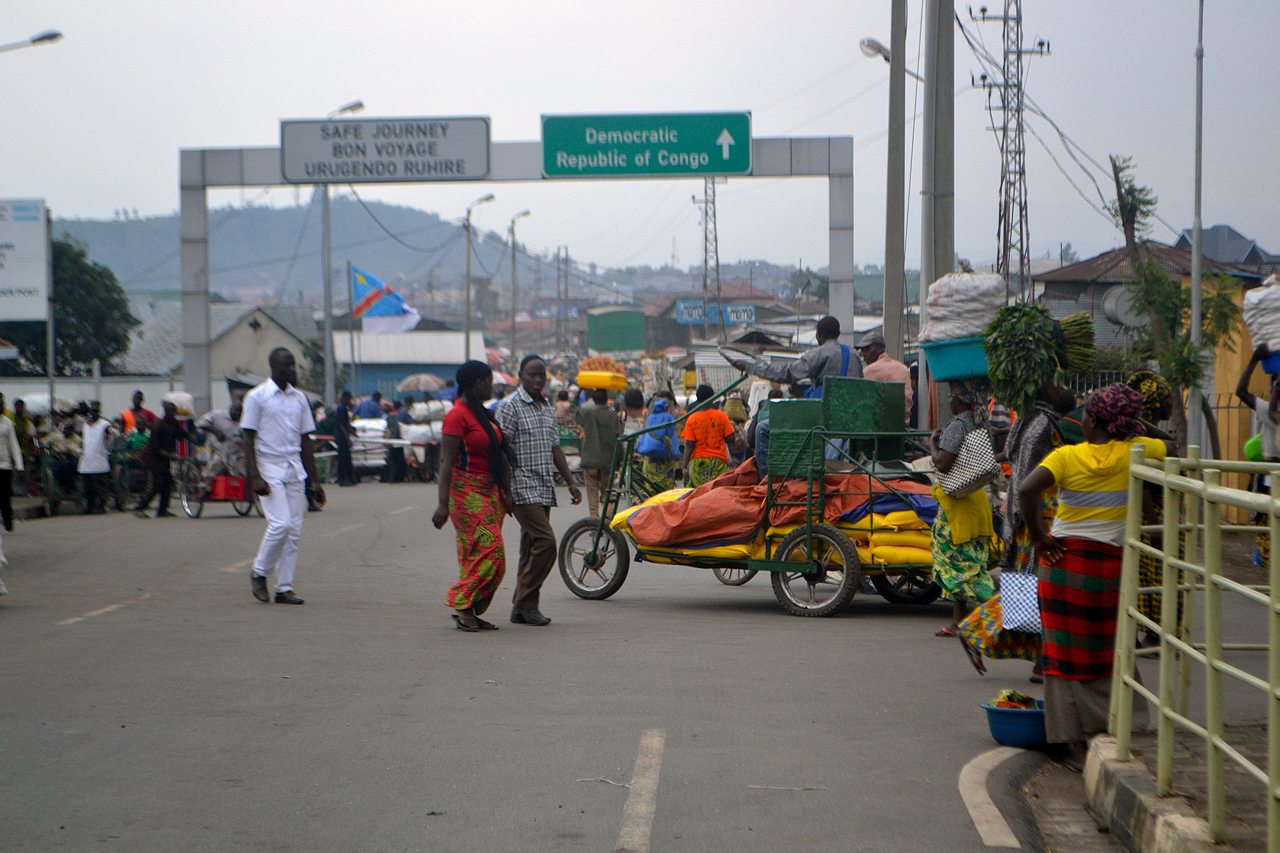Inside the national park trying to bring peace and prosperity to conflict-torn Democratic Republic of Congo.
VIRUNGA NATIONAL PARK, Democratic Republic of Congo—
Molten lava spewed forth in the more than mile-wide crater, glowing neon-red fissures breaking up the dark pit with their shifting jagged outlines. The strong, red glow of light washed over me even from the rim of the crater, roughly 1500 feet above. I was peering into Nyiragongo Volcano in Democratic Republic of Congo (DRC), home of the world’s largest lava lake.
Memories of scrambling up loose rock while enveloped in clammy fog faded away as I watched the lava lake brew. Our group of 16 hikers fell silent in the presence of something so beautiful and so deadly.
Nyiragongo’s unusually fluid lava reaches up to 60 miles per hour racing downhill and its two most recent eruptions killed more than 220 people, even with evacuation of several hundred thousand residents to neighboring Rwanda. But this dangerous force of nature could also help save the country.
In conflict-torn DRC, a force for peace and prosperity has emerged: Virunga National Park, in which the volcano is located. Virunga is Africa’s oldest and most biodiverse national park, a UNESCO World Heritage site, and home to about half of the world’s remaining population of mountain gorillas. The Virunga Alliance, an intersection of civil society, private sector, and state institutions, claims that tourism generated by the park can stabilize the country through income generation and sustainable development.
However, soon after National Geographic declared Virunga one of the world’s top destinations in 2012, M23 rebel forces overtook the volcano, forcing the park to close to tourists. M23, mostly comprised of former rebels who assimilated into the government army after a 2009 peace deal, mutinied from the army in 2012, citing the government’s failure to fulfill terms of the peace deal and poor conditions in the army. The conflict is partially fueled by animosity between the Tutsi and Hutu ethnic groups, as well as the quest for Eastern Congo’s resources, including gold, tin, and minerals used in laptops and mobile phones.

Nyiragongo Volcano reopened for tourism this past October, nearly a year after the rebel group officially ceased hostilities. Living nearby in Uganda, I saw acquaintance after acquaintance travel to the park, and the allure of witnessing the lava lake began to overrule my security concerns. But right before friends and I paid for our DRC visas and park registration fees online, several news reports came out that made us reconsider. Three people working for the United Nations had been kidnapped in Eastern Congo. Armed men, possibly rebels, were crossing into DRC from Rwanda and Uganda, changing from their paramilitary uniforms into civilian clothing before disappearing into the forest.
We wavered on the trip. “I’ll call the park to ask,” our travel companion said. “As long as people on the DRC side don’t think it’s completely reckless and insane!”
The following morning, he reported back. “The park is still safe and the border will be open. This stuff happens all the time and they’re not freaked out.” He said the park official he spoke with laughed at his concerns.
Clashes between rebels and the government have left the park staff caught in the middle, negotiating between various parties in hopes of sparing sections of the park from destruction. They worked to clear rebels from Nyiragongo Volcano while also contending with tens of thousands of displaced people who camped at its base in 2012 and 2013, trying to avoid the worst of the violence in the country.
The dangers faced by these park rangers are hardly typical occupational hazards. In Virunga, park ranger responsibilities such as protecting endangered species require policing armed poachers and paramilitary groups. More than 130 rangers have died defending the park in the past 20 years. The perils of the job are so severe that a Fallen Rangers Fund was created to provide a financial safety net for widows and children of the slain.

Because of these dangers, it is not uncommon for the rangers to come from the government army, like one senior Virunga National Park official I spoke with who declined to give his name due to security concerns. “The anti-poaching unit fights all the intruders that run illegal activities in the park,” he said. “Sometimes we ran this in joint operation with government soldiers and lost some of our rangers in the fight.”
I could not have guessed at the threats facing the park from the hike to Nyiragongo. Tranquil nature surrounded me on all sides as I walked past lush vegetation and splashes of bright flowers. Congolese women in their vividly colorful dresses climbed past us, bundles on their backs and water containers on their heads. There were small signs of the risk: the park sign at the start of the trail was ridden with bullet holes, and then there’s the fact that no one else on this hike had traveled from outside of the country: the rest already live in DRC, almost all of them NGO workers and United Nations peacekeepers.
In approximately a year, the country’s contentious presidential election will take place, potentially throwing DRC into unrest again. Experts and the opposition believe that President Joseph Kabila will attempt to stay in power beyond DRC’s constitutional two-term limit. At least 42 people have already died in protests over fears that President Kabila was trying to delay polls.
“This will not be tough[er] than the last war,” shrugged the park official when I asked how the park will deal with any election-related turmoil.

Virunga National Park does what it can to encourage tourism, working out an arrangement with the Congolese government to make it easier for tourists to enter and stay in DRC by, for example, extending the amount of time these visas are valid and making them cheaper: $105 for a 14-day tourist visa compared to a $300 seven-day normal visa. However, Congolese immigration officials often attempt to extort bribes from tourists. “Bring extra money in case you run into trouble at the border,” advised multiple people who had crossed over into DRC. Almost immediately after my travel companion handed over her passport, we ran into our own trouble.
“Journaliste! It is not possible,” the Congolese border official spat at my friend. Her passport states her profession is journalism because of her major during college, but she works at a hospital. “You go back to Uganda.”
The health worker at the border added, “Your yellow fever vaccination date is not valid. We cannot let you through.”
Our two Virunga National Park drivers pleaded with the border official and finally told us, “You wait here. We are coming back with the warden. He will bring the park permits to show you are here as tourists.”
The relationship between the park and border officials resolved any issues entering DRC, aside from a $50 fee: $30 for a new, immediately effective yellow fever vaccination and a $20 penalty for not having a valid yellow fever vaccination card. The health worker refused to let us pay the $50 without receiving a second yellow fever vaccination: a bitter-tasting spray in the mouth. Alarmed at our friend receiving two vaccinations within a short time period, we later Googled the vaccine and discovered that there is no oral yellow fever vaccine. There is also no immediately effective yellow fever vaccine.

How much can Virunga National Park and tourism save the people in Democratic Republic of Congo? “The park itself cannot stabilize the DRC,” the park official acknowledged, but still felt that the tourism would ultimately be a force for good. “Some guests are from power[ful] states, can change into donors or advocate for the country’s political situation,” he said.
This external advocacy is evident in the role that the critically acclaimed 2014 documentary Virunga—originally conceived as a film on the park’s attempts to foster tourism and jobs—played in successfully generating pressure on British oil company Soco to not explore further drilling opportunities in the park. Oil drilling in the park could endanger its UNESCO status, as well as lead to more instability in DRC if resources are misallocated, oil price volatility destabilizes government revenues, and armed groups attempt to tap into the new wealth. Media coverage has helped to highlight these dangers to a wider audience; however, the park’s future remains uncertain. This spring, the DRC’s prime minister said that the government was still interested in looking for oil within the park.
Virunga National Park’s recent period of calm is credited to DRC’s relative stabilization after the U.N. secured a 2013 regional agreement to end the M23 insurgence. Whether that relationship runs both ways, and tourism will contribute to the country’s stability, remains to be seen. The park invests a minimum 30% of its revenues in community development projects. “These projects are defined by the community and are based on the principle of free and informed consultation with civil society groups,” boasts Virunga’s fancy website, which freezes my Ugandan Internet with its high-resolution photos, overlaid text boxes, and Venn diagrams.

The 2008-2020 economic development plan for the four million people who live within a day’s walk of the 3,012 square mile park’s borders has ambitious projections for 2015: $0.2 million invested in community programs, $40 million in sustainable fisheries, five new schools, two new health clinics, 42 miles of road repaired, 28,000 people with access to clean water, and 120 direct and 500 indirect tourism-related jobs—all in this year alone. However, it is unclear whether the park is on track with its development goals, and attempts to verify progress were met with silence.
Meanwhile, Virunga National Park awaits, hoping its fiery lava lake and mountain gorillas will increase the trickle of tourists across DRC’s borders. Returning to re-watch the lava lake lazily furl and unfurl its hot tendrils is more than tempting; the prospect of seeing the gorillas and exploring everything else Virunga has to offer almost confirms my next trip. But what lingers most from my experience are the park officials, with their quiet and steely resolve, advocating for us with immigration officers, good-naturedly obliging photo seekers before returning to their watch over our group, doing everything that they can for their beautiful country and the promise it holds—for this, I will come back.